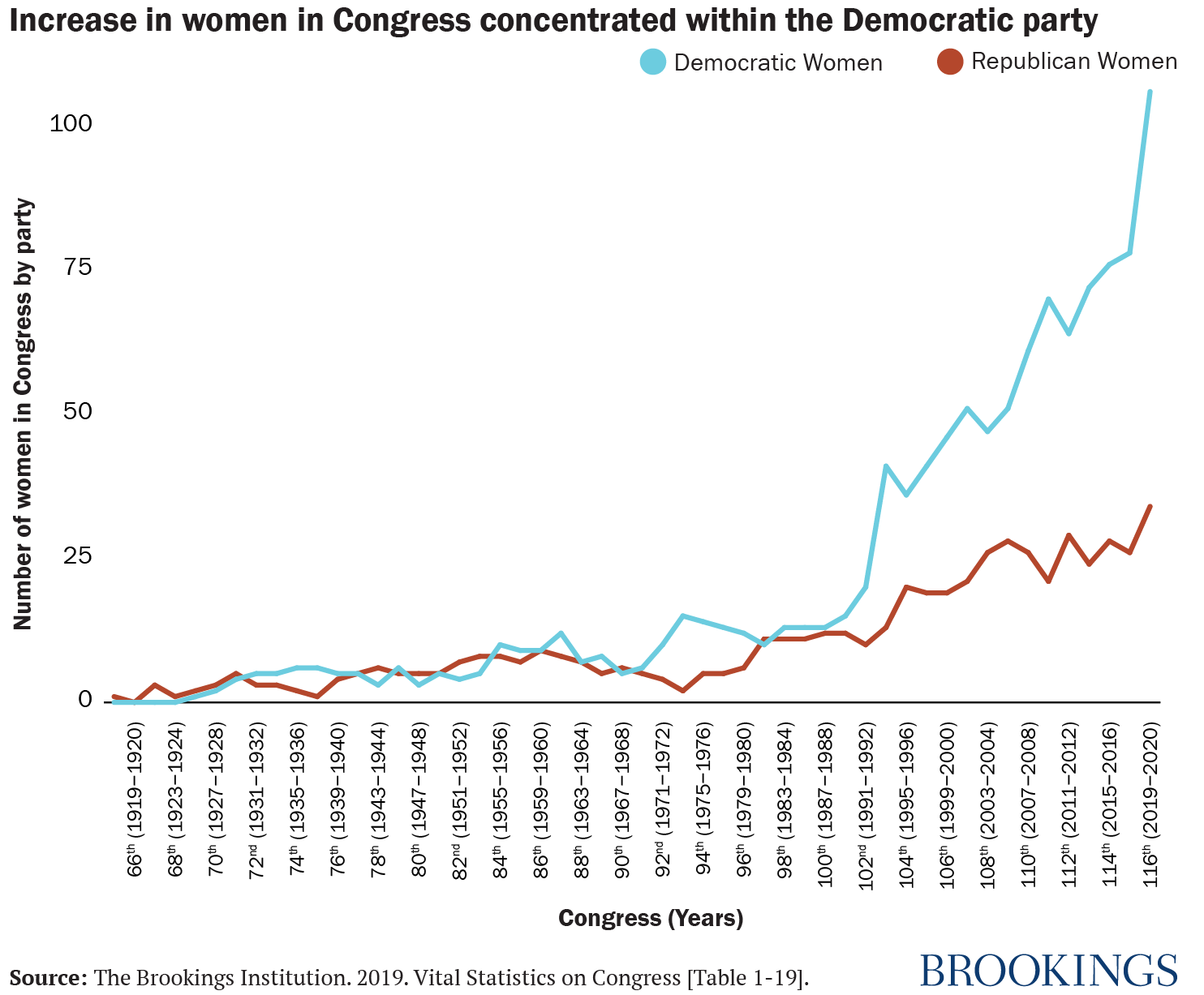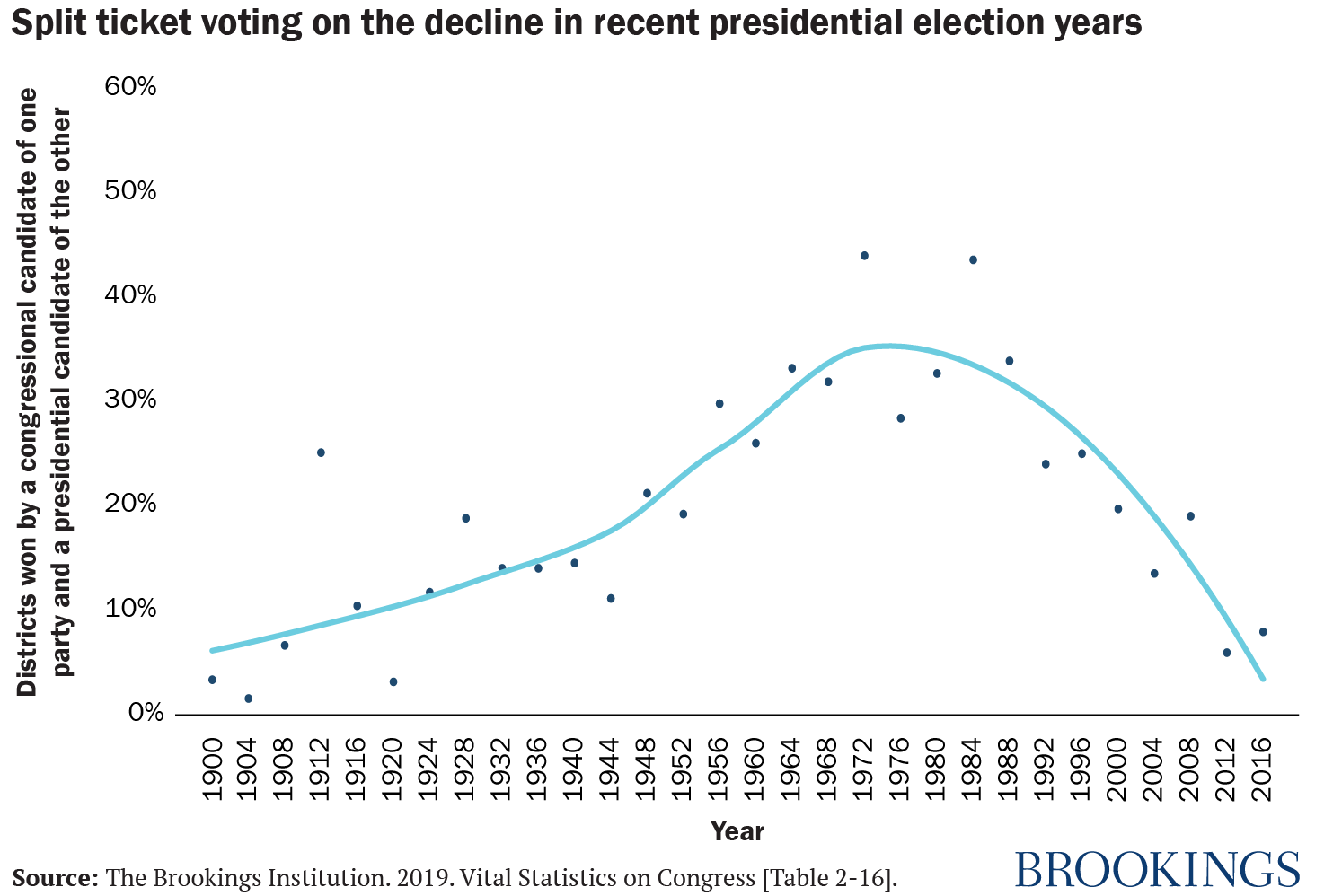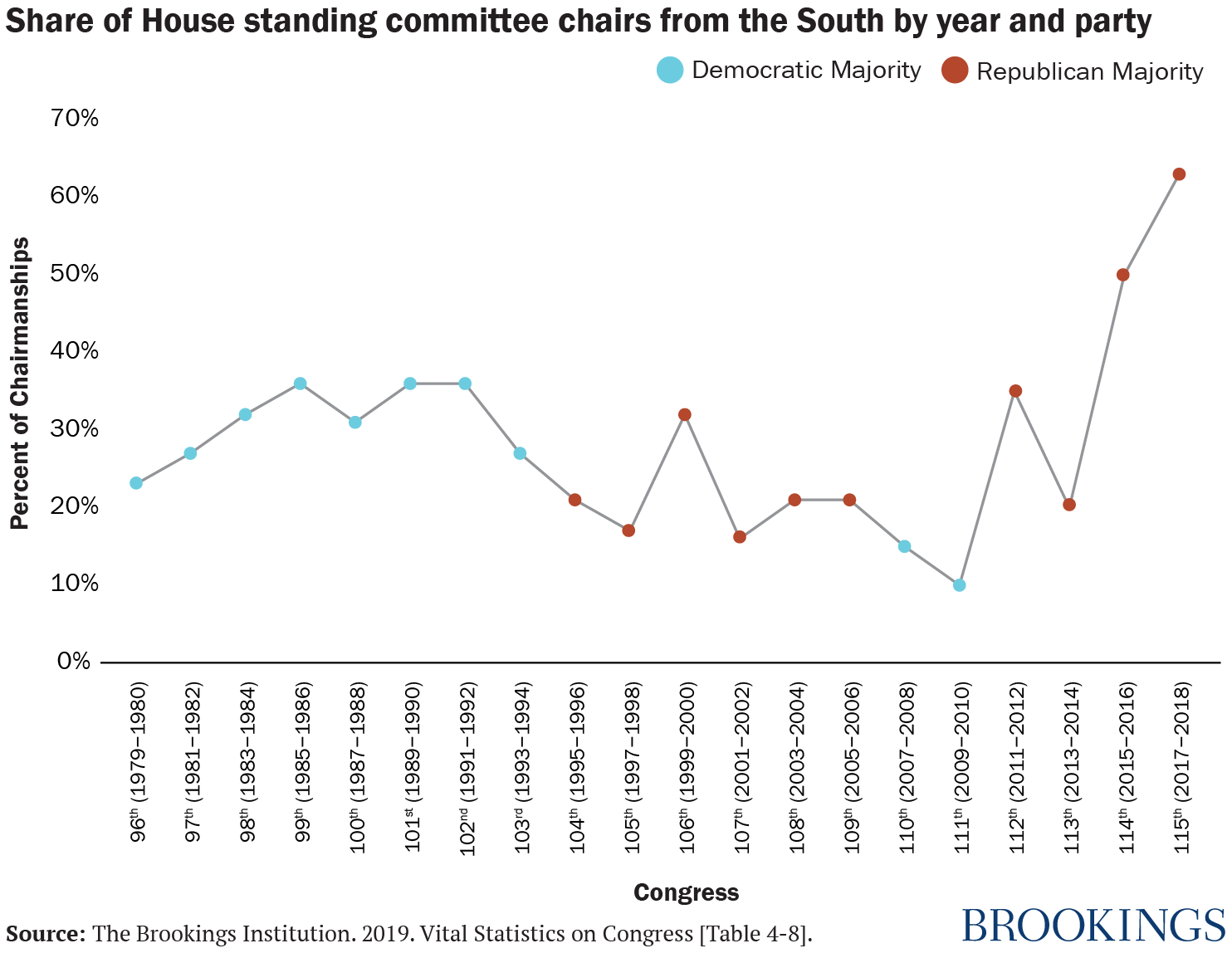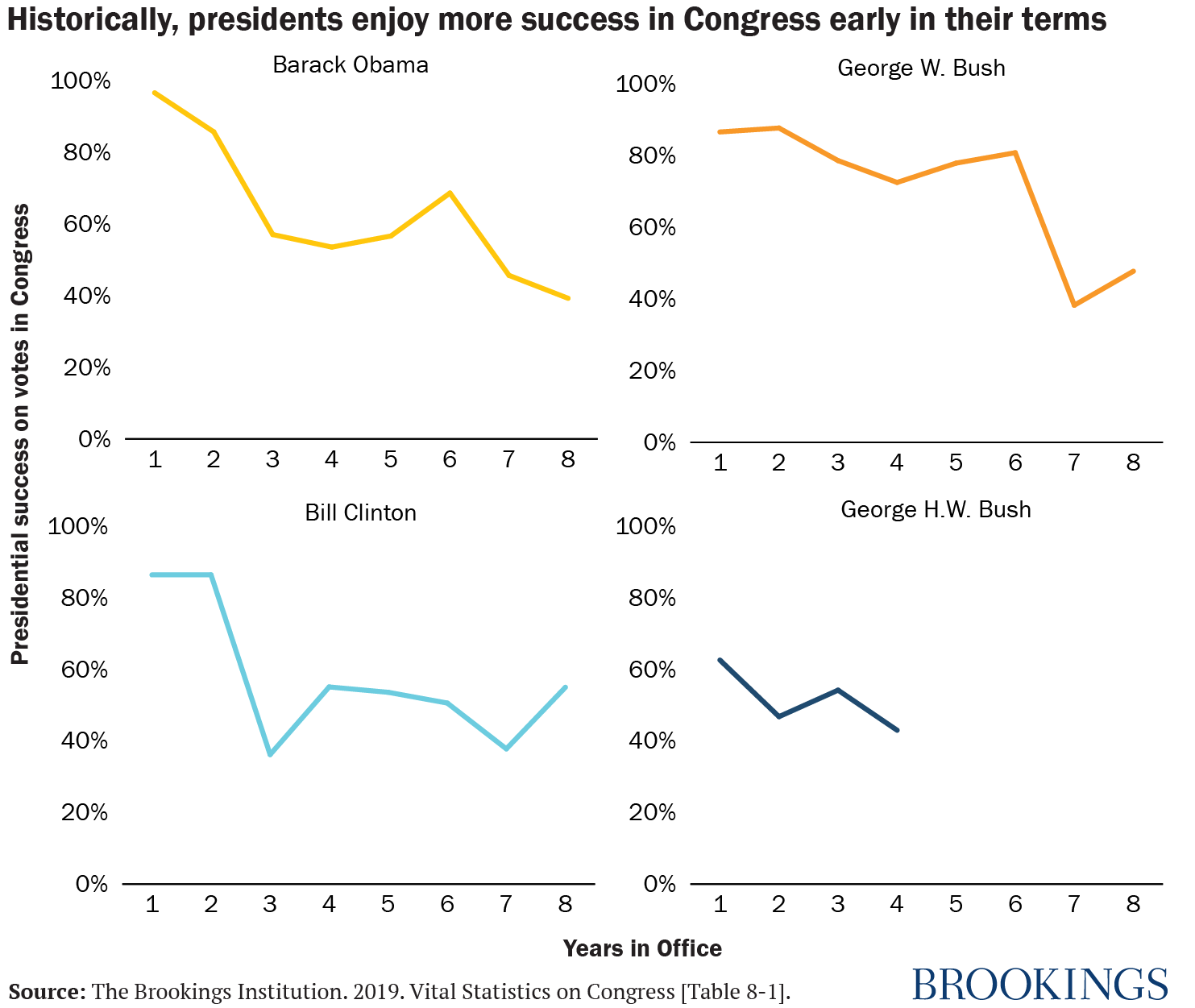
Vital Statistics on Congress, first published in 1980, long ago became the go-to source of impartial data on the United States Congress. Vital Statistics’ purpose is to collect and provide useful data on America’s first branch of government, including data on the composition of its membership, its formal procedure (such as the use of the filibuster), informal norms, party structure, and staff. With some chapters of data dating back nearly 100 years, Vital Statistics also documents how Congress has changed over time, illustrating, for example, the increasing polarization of Congress and the diversifying demographics of those who are elected to serve.
Click here to access the Vital Statistics data tables »
Vital Statistics began as a joint effort undertaken by Thomas E. Mann of Brookings and Norman J. Ornstein of the American Enterprise Institute, in collaboration with Michael Malbin of the Campaign Finance Institute. The datasets were published in print until 2013 when the project migrated online for the first time. This year, Brookings’ Molly E. Reynolds spearheaded Vital Statistics’ most recent update. The eight chapters below contain more than 90 tables of data which were collected through the years of this project and updated most recently in November 2022. Whether you are new to Vital Statistics or an old Vital Statistics hand, here are a few things to know about the most recent update:
- Each individual chapter and table is available for download below at no cost.
- Each table is available in several formats, including—for the first time—as .csv files oriented in long, rather than wide, format. (The long format files do not contain the same source and methodological note information as the .xlsx and .pdf formats, so we strongly encourage you to download one other file format as well before using the data.)
- As we’ve worked to update the data, we’ve made some changes to information from earlier years in order to correct coding errors and align methodology. A list of these changes are included in this document, and individual tables include a note indicating when earlier data was changed.
- We encourage you to use these data in your own analyses and to send any questions or feedback you may have, by contacting vitalstatistics@brookings.edu.
Want to be informed about future updates to Vital Statistics? Sign up to receive email notifications about new data releases.
Acknowledgements
Vital Statistics is overseen by Molly Reynolds. Naomi Maehr provided principal research support for the November 2022 update; additional assistance on recent updates was provided by Jackson Gode, Curtlyn Kramer, Nick Zeppos, Danielle Bates, Natalie Smith, Claire Meczkowski, Emma Tatem, Tanner Lockhead, Christian Potter, Mohammed Memfis, and Kennedy Teel. Data collection for Chapter 3 was performed by Michael Malbin, Brendan Glavin, and the team at the Campaign Finance Institute. Work on all recent updates was informed considerably by the work of all past Vital Statistics authors and contributors, especially Thomas E. Mann, Norman J. Ornstein, Raffaela Wakeman, Andrew Rugg, and countless research assistants and interns at Brookings and AEI.

Who are our members of Congress, what are their backgrounds, and from which part of the country do they come? This chapter provides data on apportionment, partisan makeup, and regional party representation of each Congress, as well as demographic information on members such as geographic origins, seniority status, prior occupations, religious affiliation, and ethnicity.
For additional detail regarding the coding methodology used in tables 1-8 through 1-13, please see this table.
Data Tables
-
1-1 Apportionment of Congressional Seats, by Region and State, 1910 - 2010 (435 seats)
-
1-2 Democratic Party Strength in the House, by Region, 69th - 117th Congresses, 1925 - 2021
-
1-3 Democratic and Republican Seats in the House, by Region, 69th - 117th Congresses, 1925 - 2021
-
1-4 Democratic Party Strength in the Senate, by Region, 69th - 117th Congresses, 1925 - 2021
-
1-5 Democratic and Republican Seats in the Senate, by Region, 69th - 117th Congresses, 1925 - 2021
-
1-6 Seniority of Representatives, 1953 - 2021
-
1-7 Seniority of Senators, 1953 - 2021
-
1-8 Prior Occupations of Representatives, 83rd - 117th Congresses, 1953 - 2021
-
1-9 Prior Occupations of Democratic Representatives, 83rd - 117th Congresses, 1953 - 2021
-
1-10 Prior Occupations of Republican Representatives, 83rd - 117th Congresses, 1953 - 2021
-
1-11 Prior Occupations of Senators, 83rd - 117th Congresses, 1953 - 2021
-
1-12 Prior Occupations of Democratic Senators, 83rd - 117th Congresses, 1953 - 2021
-
1-13 Prior Occupations of Republican Senators, 83rd - 117th Congresses, 1953 - 2021
-
1-14 Religious Affiliations of Representatives, 89th - 117th Congresses, 1965 - 2021
-
1-15 Religious Affiliations of Senators, 89th - 117th Congresses, 1965 - 2021
-
1-16 African Americans in Congress, 41st - 117th Congresses, 1869 - 2021
-
1-17 Asian Americans in Congress, 58th - 117th Congresses, 1903 - 2021
-
1-18 Hispanic Americans in Congress, 41st - 117th Congresses, 1869 - 2021
-
1-19 Women in Congress, 65th - 117th Congresses, 1917 - 2021
-
1-20 Political Parties of Senators and Representatives, 34th - 117th Congresses, 1855 - 2021
-
1-21 Gender Identity and Sexual Orientation of Representatives, 117th Congress, 2021
-
1-22 Gender Identity and Sexual Orientation of Senators, 117th Congress, 2021

How competitive are congressional races across America? Chapter 2 offers information on the results of U.S. congressional elections, including re-election rates, seats that changed parties, elections won with significant majorities and those that were close.
Data Tables
-
2-1 Turnout in Presidential and House Elections, 1930 - 2020 (percentage of voting age population)
-
2-2 Popular Vote and House Seats Won by Party, 1946 - 2020
-
2-3 Net Party Gains in House and Senate Seats, General and Special Elections, 1946 - 2020
-
2-4 Losses by the President's Party in Midterm Elections, 1862 - 2018
-
2-5 House Seats That Changed Party, 1954 - 2020
-
2-6 Senate Seats That Changed Party, 1954 - 2020
-
2-7 House Incumbents Retired, Defeated, or Reelected, 1946 - 2020
-
2-8 Senate Incumbents Retired, Defeated, or Reelected, 1946 - 2020
-
2-9 House and Senate Retirements by Party, 1930 - 2020
-
2-10 Defeated House Incumbents, 1946 - 2020
-
2-11 Defeated Senate Incumbents, 1946 - 2020
-
2-12 House Elections Won with 60 Percent of Major Party Vote, 1956 - 2020
-
2-13 Senate Elections Won with 60 Percent of Major Party Vote, 1944 - 2020
-
2-14 Marginal Races Among Members of the 117th Congress, 2020
-
2-15 Conditions of Initial Election for Members of the 117th Congress, 2021
-
2-16 Ticket Splitting between Presidential and House Candidates, 1900 - 2016
-
2-17 District Voting for President and Representative, 1952 - 2016
-
2-18 Shifts in Democratic Major Party Vote in Congressional Districts, 1956 - 2018
-
2-19 Party-Line Voting in Presidential and Congressional Elections, 1956 - 2018 (as a percentage of all voters)

How much money do successful congressional candidates spend to win a seat in the Senate or the House? Chapter 3 details campaign finance expenditures by members of Congress, as well as the spending habits of political action committees. This data was collected by Michael Malbin, Brendan Glavin, and the team at the Campaign Finance Institute. Data include the cost of winning an election by election cycle, how much incumbents spent on their re-election campaigns, and total funds raised by national party committees.
Data Tables
-
3-1 The Cost of Winning an Election, 1986-2018 (in nominal and 2018 dollars)
-
3-2 House Campaign Expenditures: Major Party General Election Candidates, 1974-2018 (full cycle), Adjusted for inflation, 2018 Dollars
-
3-3 House Campaign Expenditures: Incumbents and Challengers, Major Party General Election Candidates by Election Outcome, 1974-2018 (full cycle), Adjusted for Inflation, 2018 Dollars
-
3-4 House Campaign Expenditures: Open House Seats, Major Party General Election Candidates by Election Outcome, 1984-2018 (full cycle), Adjusted for Inflation, 2018 Mean Net Dollars
-
3-5 Senate Campaign Expenditures: Major Party General Election Candidates, 1974-2018 (full cycle, net dollars), Adjusted for Inflation, 2018 Mean Net Dollars
-
3-6 Senate Campaign Expenditures: Incumbents and Challengers, Major Party General Election Candidates by Election Outcome, 1980-2018 (full cycle), Adjusted for Inflation, 2018 Mean Net Dollars
-
3-7 Senate Expenditures: Open Senate Seats, Major Party General Election Candidates, by Election Outcome, 1986-2018 (full cycle, mean net dollars), Adjusted for Inflation, 2018 Mean Net Dollars
-
3-8 Campaign Funding Sources: House and Senate Major Party General Election Candidates, 1984-2018
-
3-9 Number Political Action Committees Making Contributions to Candidates, 1976-2018
-
3-10 PAC Contributions to Congressional Candidates 1978-2018 (in $ millions), Adjusted for Inflation, 2018 Mean Net Dollars
-
3-11 How PACs Distributed Their Contributions to Congressional Candidates, 1978-2018
-
3-12 Political Party Contributions, Coordinated and Independent Expenditures for Congressional Candidates, 1976-2018, Adjusted for Inflation, 2018 Mean Net Dollars
-
3-13 Hard and Soft Money Raised by National Party Committees, 1992-2018 (in millions of dollars), Adjusted for inflation, 2018 Dollars
-
3-14 Non-Party Independent Expenditures in House and Senate Elections, 1978-2018, Adjusted for inflation, 2018 Dollars

Chapter 4 explores the size and quantity of congressional committees in the House and the Senate. Data includes the type of committees active in each Congress, how many committees each member of Congress has been assigned, and the majority chairmanships of congressional committees.
Data Tables
-
4-1 Number of Committees in the Senate and House, 84th - 116th Congresses, 1955 - 2019
-
4-2 Number and Type of House Committees, 84th - 116th Congresses, 1955 - 2019
-
4-3 Number and Type of Senate Committees, 84th - 116th Congresses, 1955 - 2019
-
4-4 Committee Assignments for Representatives, 84th - 116th Congresses, 1955 - 2019
-
4-5 Committee Assignments for Senators, 84th - 116th Congresses, 1955 - 2019
-
4-6 Majority Party Chairmanships of House Committees and Subcommittees, 84th - 116th Congresses, 1955 - 2019
-
4-7 Majority Party Chairmanships of Senate Committees and Subcommittees, 84th - 116th Congresses, 1955 - 2019
-
4-8 Southern Chairmanships of House and Senate Standing Committees, 84th - 116th Congresses, 1955 - 2019

How much money, and how many staff people, does it take to keep Congress up and running? Chapter 5 enumerates the size of congressional staff—for individual members as well as for committees—and the appropriations for member offices.
Data Tables
-
5-1 Congressional Staff, 1979 - 2015
-
5-2 Staffs of Members of the House and Senate, 1891 - 2015
-
5-3 House Staff Based in District Offices, 1970 - 2016
-
5-4 Senate Staff Based in State Offices, 1972 - 2016
-
5-5 Staffs of House and Senate Committees, 1891 - 2015
-
5-6 Staffs of House Standing Committees, 1947 - 2015
-
5-7 Staffs of Senate Standing Committees, 1947 - 2015
-
5-8 Staffs of Congressional Support Agencies, FY1946 - FY2015
-
5-9 Legislative Branch Appropriations and the Consumer Price Index, 1946 - 2016
-
5-10 Legislative Branch Appropriations, by Category, Fiscal Years 1984 - 2016 (in thousands of dollars)
-
5-11 Allowances for Representatives, 1977 - 2016
-
5-12 Allowances for Senators, 1977 - 2016

How much has each Congress accomplished over the years, and how does the most recent Congress’ productivity compare to those of legislative bodies past? Chapter 6 reviews legislative productivity in the House and Senate over time, providing detailed data on number and length of bills passed, recorded votes in both chambers and the use of cloture motions in the Senate, among other data points.
Data Tables
-
6-1 House Workload, 80th - 115th Congresses, 1947 - 2018
-
6-2 Senate Workload, 80th - 115th Congresses, 1947 - 2018
-
6-3 Recorded Votes in the House and the Senate, 80th - 115th Congresses, 1947 - 2018
-
6-4 Congressional Workload, 80th - 115th Congresses, 1947 - 2018
-
6-5 Pages in the Federal Register, 1936 - 2017
-
6-6 Vetoes and Overrides, 80th - 114th Congresses, 1947 - 2018
-
6-7 Attempted and Successful Cloture Votes, 66th - 114th Congress, 1919 - 2018

Tables in chapter 7 provide insight into Congress’ work on the federal budget, including votes in both chambers on adopting budget resolutions and other budget-related measures, spending and appropriations, and the use of continuing resolutions to keep the government funded.
Data Tables
-
7-1 House Votes on Adoption of Budget Resolutions, by Party, FY1976 - FY2019
-
7-2 Senate Votes on Adoption of Budget Resolutions, by Party, FY1976 - FY2019
-
7-3 Budgeted and Actual Revenues, Budget Authority, Outlays, and Deficits, FY1976 - FY2017 (billions of dollars)
-
7-4a Relatively Uncontrollable Federal Outlays under Present Law, FY1967 - FY2011 (billions of dollars)
-
7-4b Mandatory and discretionary outlays under current law FY 1962 - 2017 (millions of dollars)
-
7-5 Supplemental Appropriations, FY1970 - FY2018
-
7-6 Continuing Appropriations, FY1977 - FY2019
-
7-7 Budget-Related Roll Call Votes in the House, Selected Years, 1955 - 2014
-
7-8 Budget-Related Roll Call Votes in the Senate, Selected Years, 1955 - 2014

Chapter 8 documents the rise in political polarization in Congress and trends in voting alignment. The data includes ideological scores for House and Senate party coalitions and committees, party unity votes and scores, and roll call votes on bills on which the president has taken an official position.
Data Tables
-
8-1 Presidential Victories on Votes in Congress, 1953 - 2016
-
8-2 Congressional Voting in Support of the President's Position, 1954 - 2016 (percent)
-
8-3 Party Unity Votes in Congress, 1953 - 2016 (percentage of all votes)
-
8-4 Party Unity Scores in Congressional Voting, 1954 - 2016 (percent)
-
8-5 Conservative Coalition Votes and Victories in Congress, 1957 - 2000 (percent)
-
8-6 Votes in Support of the Conservative Coalition, 1959 - 2000 (percent)
-
8-7 Average Ideological Positions of House Committees, 80th - 113th Congresses
-
8-8 Average Ideological Positions of Senate Committees, 80th - 113th Congresses
-
8-9 Average Ideological Positions of House Party Coalitions, 80th - 114th Congresses, 1947 - 2015
-
8-10 Average Ideological Positions of Senate Party Coalitions, 80th - 114th Congresses, 1947 - 2015

